An official website of the United States government
 United States Department of Labor
United States Department of Labor
Plan, direct, or coordinate the activities of buyers, purchasing officers, and related workers involved in purchasing materials, products, and services. Includes wholesale or retail trade merchandising managers and procurement managers.
Employment estimate and mean wage estimates for Purchasing Managers:
| Employment (1) | Employment RSE (3) |
Mean hourly wage |
Mean annual wage (2) |
Wage RSE (3) |
|---|---|---|---|---|
| 70,960 | 0.9 % | $ 63.78 | $ 132,660 | 0.4 % |
Percentile wage estimates for Purchasing Managers:
| Percentile | 10% | 25% | 50% (Median) |
75% | 90% |
|---|---|---|---|---|---|
| Hourly Wage | $ 35.85 | $ 46.35 | $ 60.55 | $ 76.04 | $ 95.01 |
| Annual Wage (2) | $ 74,570 | $ 96,400 | $ 125,940 | $ 158,160 | $ 197,630 |
Industries with the highest published employment and wages for Purchasing Managers are provided. For a list of all industries with employment in Purchasing Managers, see the Create Customized Tables function.
Industries with the highest levels of employment in Purchasing Managers:
| Industry | Employment (1) | Percent of industry employment | Hourly mean wage | Annual mean wage (2) |
|---|---|---|---|---|
| Management of Companies and Enterprises | 12,010 | 0.50 | $ 71.99 | $ 149,730 |
| Federal Executive Branch (OEWS Designation) | 5,090 | 0.24 | $ 68.02 | $ 141,490 |
| Aerospace Product and Parts Manufacturing | 2,600 | 0.50 | $ 67.11 | $ 139,590 |
| Merchant Wholesalers, Durable Goods (4232, 4233, 4235, 4236, 4237, and 4239 only) | 2,130 | 0.16 | $ 61.69 | $ 128,310 |
| Local Government, excluding schools and hospitals (OEWS Designation) | 2,110 | 0.04 | $ 51.97 | $ 108,100 |
Industries with the highest concentration of employment in Purchasing Managers:
| Industry | Employment (1) | Percent of industry employment | Hourly mean wage | Annual mean wage (2) |
|---|---|---|---|---|
| Aerospace Product and Parts Manufacturing | 2,600 | 0.50 | $ 67.11 | $ 139,590 |
| Management of Companies and Enterprises | 12,010 | 0.50 | $ 71.99 | $ 149,730 |
| Navigational, Measuring, Electromedical, and Control Instruments Manufacturing | 2,020 | 0.48 | $ 68.64 | $ 142,760 |
| Oil and Gas Extraction | 590 | 0.47 | $ 73.30 | $ 152,460 |
| Communications Equipment Manufacturing | 370 | 0.44 | $ 62.57 | $ 130,150 |
Top paying industries for Purchasing Managers:
| Industry | Employment (1) | Percent of industry employment | Hourly mean wage | Annual mean wage (2) |
|---|---|---|---|---|
| Other Information Services | 110 | 0.03 | $ 81.82 | $ 170,180 |
| Apparel, Piece Goods, and Notions Merchant Wholesalers | 450 | 0.35 | $ 79.94 | $ 166,280 |
| Securities, Commodity Contracts, and Other Financial Investments and Related Activities | 90 | 0.01 | $ 79.59 | $ 165,540 |
| Legal Services | 70 | 0.01 | $ 76.68 | $ 159,500 |
| Computer Systems Design and Related Services | 2,030 | 0.09 | $ 76.44 | $ 159,000 |
States and areas with the highest published employment, location quotients, and wages for Purchasing Managers are provided. For a list of all areas with employment in Purchasing Managers, see the Create Customized Tables function.
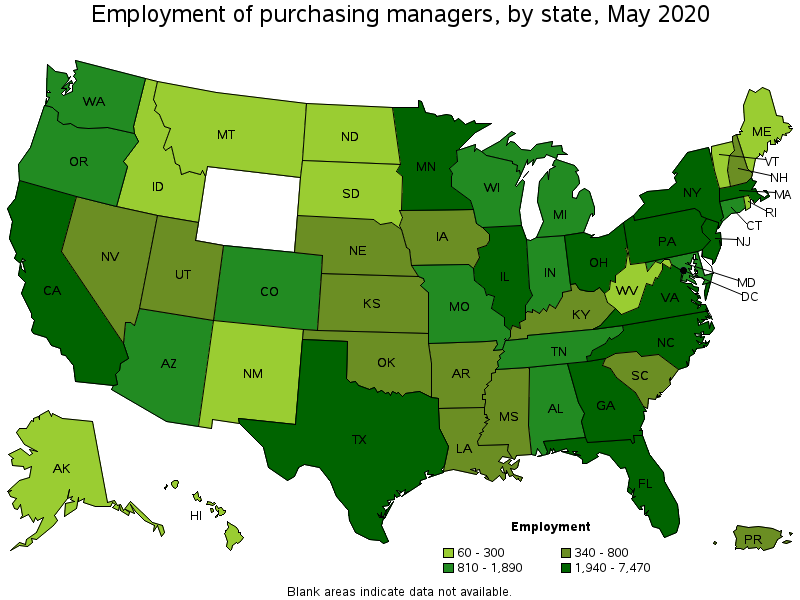
States with the highest employment level in Purchasing Managers:
| State | Employment (1) | Employment per thousand jobs | Location quotient (9) | Hourly mean wage | Annual mean wage (2) |
|---|---|---|---|---|---|
| California | 7,470 | 0.45 | 0.89 | $ 71.08 | $ 147,850 |
| Texas | 6,480 | 0.54 | 1.05 | $ 65.81 | $ 136,890 |
| New York | 4,400 | 0.51 | 0.99 | $ 76.27 | $ 158,650 |
| Illinois | 3,990 | 0.71 | 1.39 | $ 62.09 | $ 129,140 |
| Florida | 2,990 | 0.35 | 0.69 | $ 56.59 | $ 117,710 |
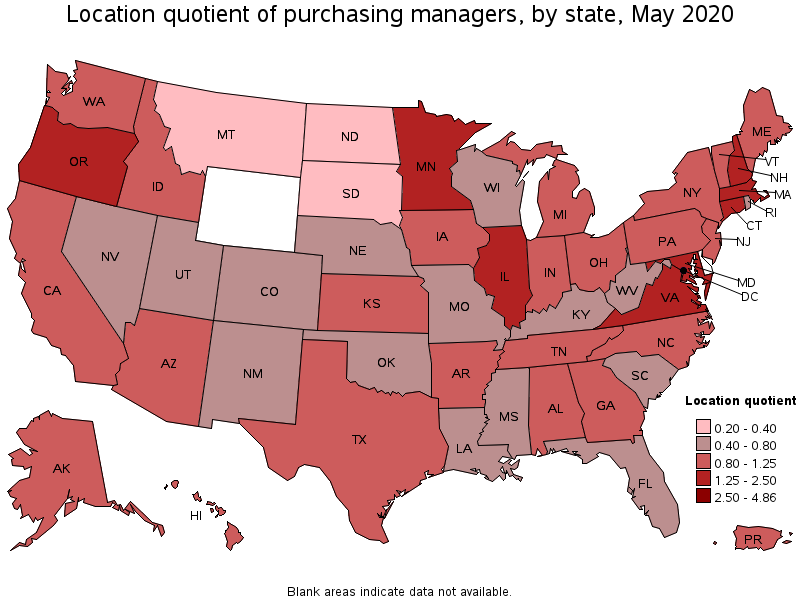
States with the highest concentration of jobs and location quotients in Purchasing Managers:
| State | Employment (1) | Employment per thousand jobs | Location quotient (9) | Hourly mean wage | Annual mean wage (2) |
|---|---|---|---|---|---|
| District of Columbia | 1,700 | 2.48 | 4.86 | $ 71.47 | $ 148,660 |
| Connecticut | 1,830 | 1.19 | 2.33 | $ 63.53 | $ 132,130 |
| Massachusetts | 2,780 | 0.83 | 1.63 | $ 67.28 | $ 139,930 |
| New Hampshire | 490 | 0.80 | 1.56 | $ 64.01 | $ 133,140 |
| Oregon | 1,360 | 0.75 | 1.48 | $ 54.57 | $ 113,500 |
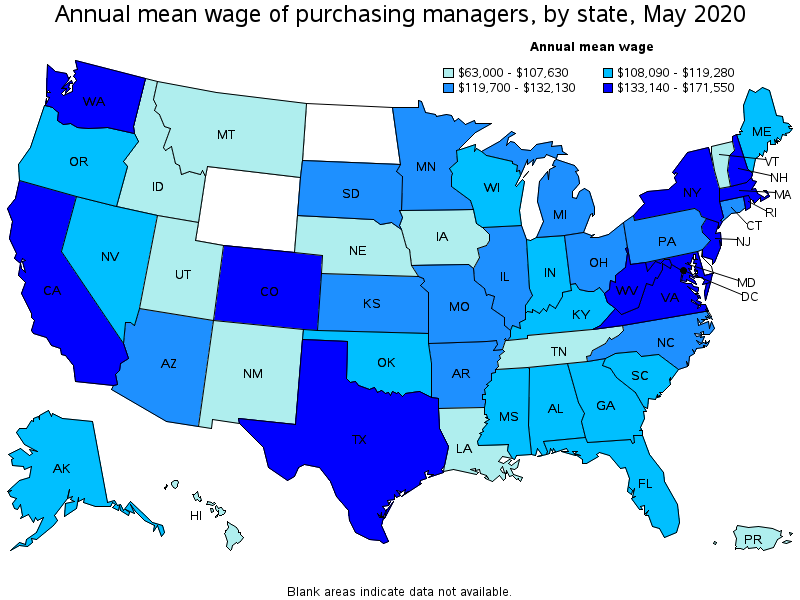
Top paying states for Purchasing Managers:
| State | Employment (1) | Employment per thousand jobs | Location quotient (9) | Hourly mean wage | Annual mean wage (2) |
|---|---|---|---|---|---|
| New Jersey | 2,260 | 0.60 | 1.17 | $ 82.48 | $ 171,550 |
| New York | 4,400 | 0.51 | 0.99 | $ 76.27 | $ 158,650 |
| Colorado | 950 | 0.37 | 0.72 | $ 73.13 | $ 152,100 |
| District of Columbia | 1,700 | 2.48 | 4.86 | $ 71.47 | $ 148,660 |
| California | 7,470 | 0.45 | 0.89 | $ 71.08 | $ 147,850 |
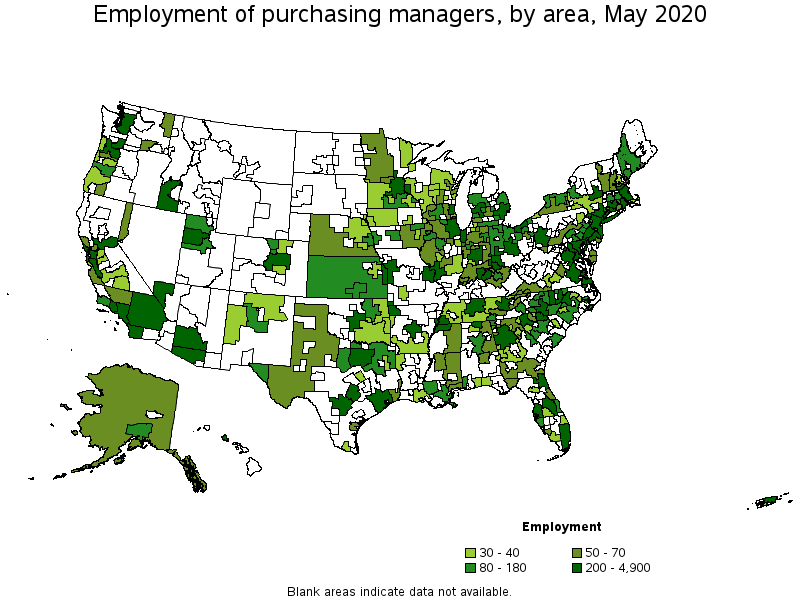
Metropolitan areas with the highest employment level in Purchasing Managers:
| Metropolitan area | Employment (1) | Employment per thousand jobs | Location quotient (9) | Hourly mean wage | Annual mean wage (2) |
|---|---|---|---|---|---|
| New York-Newark-Jersey City, NY-NJ-PA | 4,900 | 0.55 | 1.09 | $ 82.84 | $ 172,300 |
| Washington-Arlington-Alexandria, DC-VA-MD-WV | 4,200 | 1.39 | 2.73 | $ 72.36 | $ 150,520 |
| Chicago-Naperville-Elgin, IL-IN-WI | 3,230 | 0.74 | 1.45 | $ 63.16 | $ 131,370 |
| Los Angeles-Long Beach-Anaheim, CA | 2,740 | 0.47 | 0.92 | $ 72.03 | $ 149,820 |
| Boston-Cambridge-Nashua, MA-NH | 2,530 | 0.97 | 1.90 | $ 68.91 | $ 143,340 |
| Dallas-Fort Worth-Arlington, TX | 2,310 | 0.64 | 1.26 | $ 66.11 | $ 137,500 |
| Houston-The Woodlands-Sugar Land, TX | 2,050 | 0.69 | 1.35 | $ 73.02 | $ 151,880 |
| Atlanta-Sandy Springs-Roswell, GA | 1,610 | 0.61 | 1.20 | $ 59.94 | $ 124,680 |
| Minneapolis-St. Paul-Bloomington, MN-WI | 1,570 | 0.85 | 1.66 | $ 63.35 | $ 131,760 |
| Seattle-Tacoma-Bellevue, WA | 1,450 | 0.74 | 1.45 | $ 71.71 | $ 149,160 |
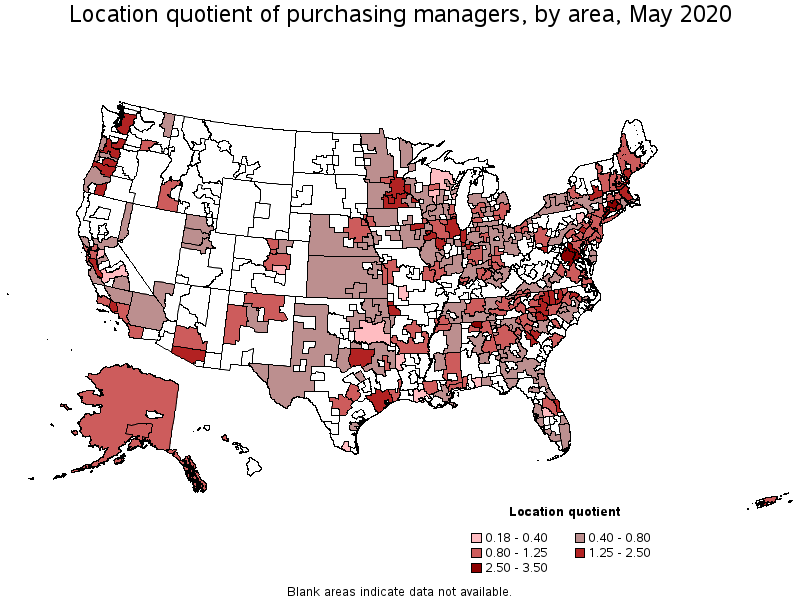
Metropolitan areas with the highest concentration of jobs and location quotients in Purchasing Managers:
| Metropolitan area | Employment (1) | Employment per thousand jobs | Location quotient (9) | Hourly mean wage | Annual mean wage (2) |
|---|---|---|---|---|---|
| Huntsville, AL | 410 | 1.76 | 3.44 | $ 60.08 | $ 124,970 |
| Hartford-West Hartford-East Hartford, CT | 800 | 1.46 | 2.87 | $ 58.26 | $ 121,180 |
| Washington-Arlington-Alexandria, DC-VA-MD-WV | 4,200 | 1.39 | 2.73 | $ 72.36 | $ 150,520 |
| Bridgeport-Stamford-Norwalk, CT | 490 | 1.29 | 2.54 | $ 79.36 | $ 165,070 |
| Danbury, CT | 90 | 1.23 | 2.41 | $ 51.91 | $ 107,980 |
| Cedar Rapids, IA | 160 | 1.18 | 2.32 | $ 62.25 | $ 129,480 |
| Fayetteville-Springdale-Rogers, AR-MO | 270 | 1.11 | 2.18 | $ 87.13 | $ 181,240 |
| Albany-Schenectady-Troy, NY | 460 | 1.10 | 2.16 | $ 48.46 | $ 100,790 |
| Portsmouth, NH-ME | 90 | 1.02 | 1.99 | $ 69.27 | $ 144,090 |
| Davenport-Moline-Rock Island, IA-IL | 170 | 1.00 | 1.95 | $ 56.59 | $ 117,710 |
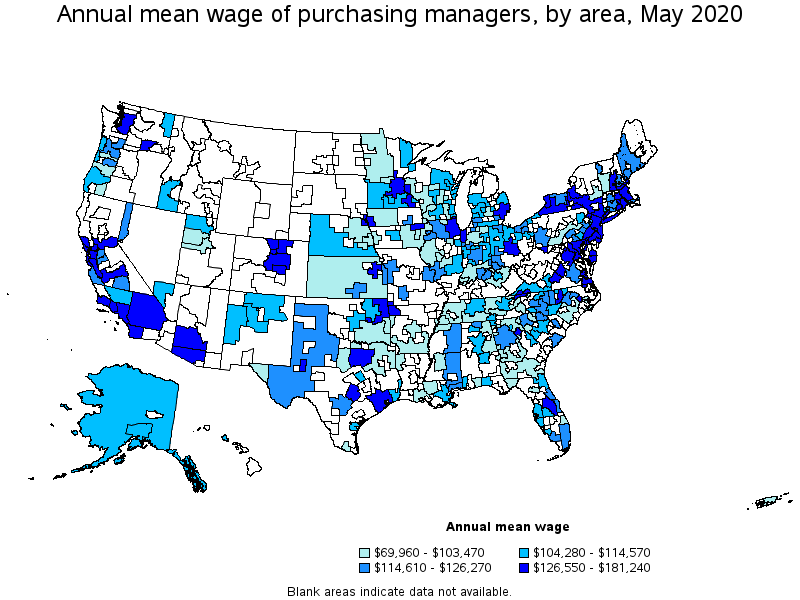
Top paying metropolitan areas for Purchasing Managers:
| Metropolitan area | Employment (1) | Employment per thousand jobs | Location quotient (9) | Hourly mean wage | Annual mean wage (2) |
|---|---|---|---|---|---|
| Fayetteville-Springdale-Rogers, AR-MO | 270 | 1.11 | 2.18 | $ 87.13 | $ 181,240 |
| New York-Newark-Jersey City, NY-NJ-PA | 4,900 | 0.55 | 1.09 | $ 82.84 | $ 172,300 |
| Morgantown, WV | 60 | 0.90 | 1.76 | $ 80.65 | $ 167,740 |
| Bridgeport-Stamford-Norwalk, CT | 490 | 1.29 | 2.54 | $ 79.36 | $ 165,070 |
| Santa Maria-Santa Barbara, CA | 90 | 0.48 | 0.95 | $ 77.64 | $ 161,490 |
| San Francisco-Oakland-Hayward, CA | 1,430 | 0.62 | 1.21 | $ 77.07 | $ 160,300 |
| Syracuse, NY | 160 | 0.57 | 1.12 | $ 76.91 | $ 159,970 |
| Boulder, CO | 80 | 0.44 | 0.86 | $ 76.79 | $ 159,720 |
| San Jose-Sunnyvale-Santa Clara, CA | 910 | 0.82 | 1.61 | $ 76.39 | $ 158,900 |
| Trenton, NJ | 160 | 0.68 | 1.32 | $ 74.92 | $ 155,820 |
Nonmetropolitan areas with the highest employment in Purchasing Managers:
| Nonmetropolitan area | Employment (1) | Employment per thousand jobs | Location quotient (9) | Hourly mean wage | Annual mean wage (2) |
|---|---|---|---|---|---|
| Kansas nonmetropolitan area | 100 | 0.28 | 0.54 | $ 46.78 | $ 97,290 |
| Piedmont North Carolina nonmetropolitan area | 100 | 0.41 | 0.80 | $ 54.91 | $ 114,220 |
| Southeast Minnesota nonmetropolitan area | 90 | 0.64 | 1.25 | $ 51.36 | $ 106,820 |
| North Northeastern Ohio nonmetropolitan area (noncontiguous) | 90 | 0.30 | 0.59 | $ 53.85 | $ 112,000 |
| Balance of Lower Peninsula of Michigan nonmetropolitan area | 90 | 0.37 | 0.73 | $ 52.72 | $ 109,660 |
Nonmetropolitan areas with the highest concentration of jobs and location quotients in Purchasing Managers:
| Nonmetropolitan area | Employment (1) | Employment per thousand jobs | Location quotient (9) | Hourly mean wage | Annual mean wage (2) |
|---|---|---|---|---|---|
| Southeast Minnesota nonmetropolitan area | 90 | 0.64 | 1.25 | $ 51.36 | $ 106,820 |
| West Central-Southwest New Hampshire nonmetropolitan area | 60 | 0.62 | 1.22 | $ 65.26 | $ 135,740 |
| Alaska nonmetropolitan area | 60 | 0.59 | 1.15 | $ 53.03 | $ 110,300 |
| Northwest Illinois nonmetropolitan area | 60 | 0.52 | 1.01 | $ 57.35 | $ 119,290 |
| Northeast Alabama nonmetropolitan area | 70 | 0.51 | 1.00 | $ 40.07 | $ 83,340 |
Top paying nonmetropolitan areas for Purchasing Managers:
| Nonmetropolitan area | Employment (1) | Employment per thousand jobs | Location quotient (9) | Hourly mean wage | Annual mean wage (2) |
|---|---|---|---|---|---|
| Central East New York nonmetropolitan area | 40 | 0.28 | 0.55 | $ 76.13 | $ 158,360 |
| West Central-Southwest New Hampshire nonmetropolitan area | 60 | 0.62 | 1.22 | $ 65.26 | $ 135,740 |
| Northeast Oklahoma nonmetropolitan area | 40 | 0.34 | 0.66 | $ 62.26 | $ 129,500 |
| Southwest New York nonmetropolitan area | 60 | 0.38 | 0.74 | $ 61.48 | $ 127,870 |
| Southeast Mississippi nonmetropolitan area | 60 | 0.42 | 0.82 | $ 57.76 | $ 120,130 |
These estimates are calculated with data collected from employers in all industry sectors, all metropolitan and nonmetropolitan areas, and all states and the District of Columbia. The top employment and wage figures are provided above. The complete list is available in the downloadable XLS files.
The percentile wage estimate is the value of a wage below which a certain percent of workers fall. The median wage is the 50th percentile wage estimate—50 percent of workers earn less than the median and 50 percent of workers earn more than the median. More about percentile wages.
(1) Estimates for detailed occupations do not sum to the totals because the totals include occupations not shown separately. Estimates do not include self-employed workers.
(2) Annual wages have been calculated by multiplying the hourly mean wage by a "year-round, full-time" hours figure of 2,080 hours; for those occupations where there is not an hourly wage published, the annual wage has been directly calculated from the reported survey data.
(3) The relative standard error (RSE) is a measure of the reliability of a survey statistic. The smaller the relative standard error, the more precise the estimate.
(9) The location quotient is the ratio of the area concentration of occupational employment to the national average concentration. A location quotient greater than one indicates the occupation has a higher share of employment than average, and a location quotient less than one indicates the occupation is less prevalent in the area than average.
Other OEWS estimates and related information:
May 2020 National Occupational Employment and Wage Estimates
May 2020 State Occupational Employment and Wage Estimates
May 2020 Metropolitan and Nonmetropolitan Area Occupational Employment and Wage Estimates
May 2020 National Industry-Specific Occupational Employment and Wage Estimates
Last Modified Date: March 31, 2021